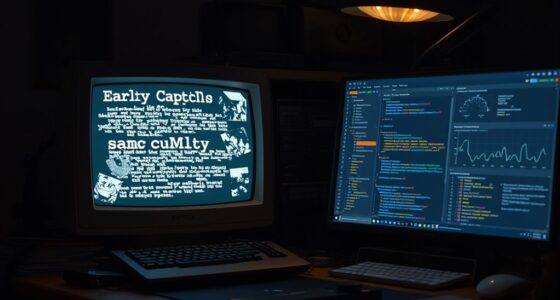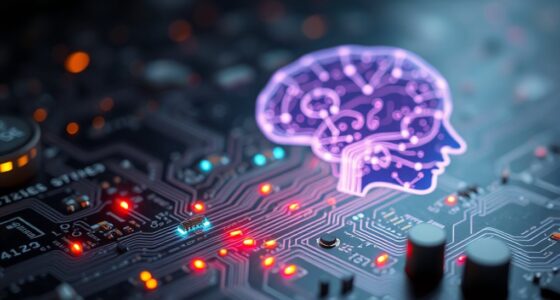Generative AI blends technology with creativity to create images, music, and text. It analyzes patterns from vast datasets to mimic human styles and produce unique content. While it’s a powerful tool that enhances artistic expression, it also raises questions about ownership and ethics. Plus, there are risks of misuse, like fake news or misleading media. If you want to explore how it’s reshaping creativity and the potential concerns, there’s much more to uncover.
Key Takeaways
- Generative AI utilizes advanced algorithms to analyze patterns in existing art, music, and text to create new content.
- This technology can produce various creative outputs, including digital paintings, melodies, and text-based works.
- It serves as a collaborative tool, enhancing creativity and enabling artists to explore innovative styles and ideas.
- Ethical concerns arise regarding the ownership of AI-generated works and the authenticity of the content produced.
- The potential misuse of generative AI raises risks related to misinformation and trust in media, necessitating responsible engagement with the technology.

Have you ever wondered how machines can create art, music, or even text that feels strikingly human? This phenomenon is known as generative AI, a fascinating blend of technology and creativity. With advancements in algorithms and vast datasets, AI systems can analyze patterns in human-created works and generate new content that mirrors those styles. You might be surprised to learn just how far AI creativity has come, producing everything from stunning digital paintings to hauntingly beautiful melodies.
Yet, while the capabilities of generative AI are impressive, they also bring about ethical concerns. For instance, when an AI creates a piece of art, who owns that creation? Is it the designer of the algorithm, the programmer of the data set, or the machine itself? These questions stir up debates across the art community and beyond. You may find yourself pondering whether these AI-generated pieces can truly be considered art or merely imitations of human expression.
Moreover, the potential for misuse is another significant concern. Imagine someone using generative AI to create fake news articles or misleading imagery. The line between genuine content and manipulated media becomes increasingly blurred, raising questions about authenticity and trust. As you explore generative AI, it’s essential to reflect on these implications and how they might affect society at large.
In many cases, you’ll see AI being used as a collaborative tool, helping artists, musicians, and writers enhance their creative processes. This partnership can lead to innovative outcomes that neither party could achieve alone. By leveraging AI, creators can explore new styles and ideas, pushing the boundaries of what’s possible. Performance kits can even be tailored to enhance creativity in the artistic process, much like how they boost engine responsiveness in automotive tuning. Still, it’s vital to remain mindful of the ethical considerations involved, ensuring that innovation doesn’t come at the cost of integrity.
As you explore more deeply into the world of generative AI, you’ll likely encounter the ongoing discussions about the balance between embracing technological advancements and maintaining ethical standards. It’s a complex landscape, and your perspective will shape how you view the intersection of AI and creativity. Ultimately, understanding the nuances of AI creativity will empower you to engage with this rapidly evolving field responsibly. You’re not just an observer; you’re part of a conversation that’s redefining the very nature of creativity in the 21st century.
Frequently Asked Questions
What Ethical Concerns Arise From Using Generative AI?
Using generative AI raises ethical concerns like bias issues and privacy concerns. You might find that AI systems can perpetuate existing biases in data, leading to unfair outcomes. Additionally, there’s the risk of personal data being misused or inadequately protected, compromising individuals’ privacy. It’s essential to address these issues to guarantee that AI technologies are used responsibly and ethically, promoting fairness and safeguarding personal information in every application.
Can Generative AI Replace Human Creativity Entirely?
Generative AI can’t replace human creativity entirely; it’s like trying to substitute a roaring wildfire with a flickering candle. Sure, AI can churn out impressive art and music, but it lacks that spark of human originality. Think of it as a creative partner, not a replacement. You and AI can collaborate, blending your unique insights with its capabilities, creating something truly extraordinary together. That’s where the magic happens—when human imagination meets AI’s efficiency!
How Does Generative AI Handle Copyright Issues?
Generative AI navigates copyright issues by analyzing existing works to create new content, but it can sometimes lead to copyright infringement. You need to be cautious, as using AI-generated material that closely resembles copyrighted work could violate intellectual property laws. It is crucial to understand the rules around fair use and make sure that your AI outputs don’t replicate existing copyrights. Always consider consulting a legal expert if you’re unsure about your usage.
What Industries Are Most Impacted by Generative AI?
Generative AI’s most impacted industries are the art market and the entertainment industry. In the art market, it’s changing how artists create and sell their work, allowing for new forms of expression. Meanwhile, the entertainment industry benefits from AI-generated content, enhancing music, film, and gaming experiences. You’ll notice these shifts as creators embrace AI tools, sparking innovation while also raising questions about originality and copyright in these rapidly evolving fields.
Is Generative AI Capable of Understanding Context?
Yes, generative AI can demonstrate context comprehension and semantic understanding to some extent. It analyzes patterns in data to grasp nuances of language and context, allowing it to generate relevant responses. However, it may struggle with deeper implications or subtle cues that require human-like intuition. While it’s impressive in mimicking understanding, it doesn’t possess true awareness or consciousness, which means its contextual grasp isn’t always perfect or reliable in complex situations.
Conclusion
Generative AI opens doors to creativity, inspiring you to imagine new worlds, to compose melodies that resonate, and to craft stories that captivate. It empowers you to explore the uncharted, to express your innermost thoughts, and to connect with others in profound ways. As you embrace this technology, you’ll find your potential limitless, your creativity boundless, and your voice amplified. With generative AI, you’re not just a consumer; you’re a creator, shaping the future of art and innovation.










